Well Care
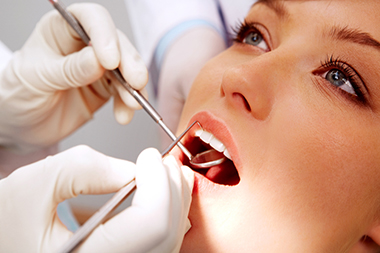 Best practice is to visit your dentist twice a year for an exam and cleaning. We understand that it is easy to get behind in this routine. That is okay. The most important thing is that you come in and get checked. Our goal is to help make sure your teeth are in good shape for years to come, and a comprehensive exam is the first step. At your initial and regular check-up exams, your dentist and hygienist will perform the following:
Best practice is to visit your dentist twice a year for an exam and cleaning. We understand that it is easy to get behind in this routine. That is okay. The most important thing is that you come in and get checked. Our goal is to help make sure your teeth are in good shape for years to come, and a comprehensive exam is the first step. At your initial and regular check-up exams, your dentist and hygienist will perform the following:
- Examination of x-rays (radiographs): X-rays are used to detect decay, tumors, cysts, and bone loss. X-rays also help determine tooth and root positions.
- Oral cancer screening: We will check the face, neck, lips, tongue, throat, tissues and gums for any signs of irregularity and oral cancer.
- Gum disease evaluation: We will check the gums, tissue and bone around the teeth for signs of any periodontal disease.
- Tooth decay: We will closely examine all tooth surfaces for any signs of decay.
- Examination of existing restorations: have fillings, crowns, etc. that may have been in place for many years. We will check the current condition of each of these.
Professional Cleaning
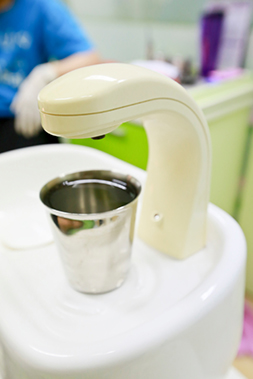 One of our registered dental hygienists will perform your professional dental cleaning. Your cleaning appointment will include a dental exam as well as the following:
One of our registered dental hygienists will perform your professional dental cleaning. Your cleaning appointment will include a dental exam as well as the following:
- Removal of calculus (tartar): tartar is hardened plaque that has accumulated on the tooth and is now firmly attached to the tooth’s surface. Tartar forms above and below the gum lineand can only be removed with special dental instruments.
- Removal of plaque: Plaque is a sticky, almost invisible film that forms on the teeth. It is a mixture of bacteria, food debris and saliva. The bacteria produce toxins that make the gums inflamed. This inflammation is the beginning stage of periodontal disease.
- Teeth polishing: Using a rotating brush, stains and plaque that is not otherwise removed during tooth brushing and scaling will be cleaned away.
X-Rays
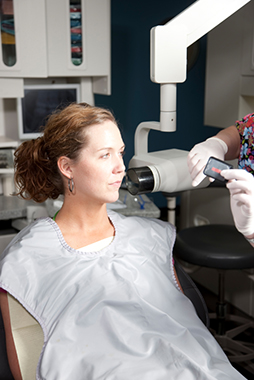 Dental radiographs (x-rays) are essential, preventative, diagnostic tools that provide valuable information not visible during a regular dental exam. Dentists and hygienists use this information to safely and accurately detect hidden dental abnormalities as well as complete an accurate treatment plan. Without x-rays, problem areas may go undetected.
Dental radiographs (x-rays) are essential, preventative, diagnostic tools that provide valuable information not visible during a regular dental exam. Dentists and hygienists use this information to safely and accurately detect hidden dental abnormalities as well as complete an accurate treatment plan. Without x-rays, problem areas may go undetected.
Dental x-rays can reveal:
- Abscesses or cysts
- Bone loss
- Tumors (benign and cancerous)
- Decay on and between the teeth
- Developmental abnormalities
- Poor tooth and root positions/structure
- Problems inside a tooth
- Problems below the gum line
Detecting and treating dental problems early on can save you time, money, discomfort and the life of your teeth!
Are dental x-rays safe?
Our patients’ safety is important. Radiation exposure is a natural occurrence in our everyday environment. The amount of radiation exposure from a full mouth series of x-rays is equal to the amount a person receives in a single day from natural sources.
Dental x-rays produce a low level of radiation and are considered safe. Our team takes precautions to limit a patient’s exposure to radiation during the x-ray process. These precautions include using lead apron shields to protect the body and using modern, fast film that cuts down the exposure time of each x-ray.
How often do you need dental x-rays?
The need for dental x-rays depends on each patient’s individual needs. Your dental care teamwill recommend x-rays as needed based on the review of your history, exam, any symptoms, age and potential risk for disease.
Comprehensive dental x-rays are recommended for all new patients. This includes x-rays of your full mouth. These generally are good for at least three years. Often, partial x-rays, usually of the teeth biting together, are taken once a year, just for comparison and to help detect any new issues.
 The mouth is the window to the body’s overall health condition, so it is important to do everything you can to be healthy. By taking good care of your teeth every day, you can significantly impact their health and longevity. A daily routine that includes balanced nutrition, exercise and good oral hygiene will help keep your body and your mouth in tip top shape.
The mouth is the window to the body’s overall health condition, so it is important to do everything you can to be healthy. By taking good care of your teeth every day, you can significantly impact their health and longevity. A daily routine that includes balanced nutrition, exercise and good oral hygiene will help keep your body and your mouth in tip top shape.
Brush your teeth at least twice a day, once in the morning and once before bed with a soft bristle brush and toothpaste (look for the ADA logo on the package).Place the brush at a 45 degree angle to the gums and brush gently using small circular motion, making sure that you feel the bristles on the gums. Then, brush the outer, inner, and biting surfaces of each tooth.Use the tip of the brush to clean the inside of the front teeth on the top and bottom. Last but not least, brush your tongue to remove bacteria and freshen your breath.
We like to recommend electric toothbrushes. They are more like a dental instrument, are easy to use and remove plaque efficiently. Simply place the bristles of the electric brush on your teeth and gums, and let the brush to the work. Even though an electric brush is highly efficient, it is still important to brush for two full minutes to ensure a comprehensive cleaning of the entire mouth.
Flossing –flossing every day is the best way to clean in between teeth and under the gumline. Flossing helps clean the spaces brushes cannot reach while also helping to dislodge food and bacteria. Long term, flossing helps keep gums, teeth and bone from being damaged by plaque build-up.
To floss, take 12-16 inches (30-40cm) of dental floss and wrap it around your index or middle fingers, leaving about two inches (5cm) of floss between the hands. Use your thumbs and forefingers to guide the floss gently between teeth using a back and forth motion.Curve the floss into a “C” shape around each tooth and under the gumline.Gently move the floss up and down, cleaning the side of each tooth.Floss holders may be used if you have difficulty using conventional floss.
It is not uncommon to have a little bit of bleeding from the gums if you are new to flossing. This should subside after a few days. Please remember to use floss gently. If bleeding continues, please let us know so we can help.
Rinsing – It is important to rinse your mouth with water after brushing and flossing to clear away any cleaning product and bacteria. If you cannot brush after meals, rinsing is a helpful alternative. If you want to use an over the counter rinse product, please let us know so we can help determine the right product.
- Alter the shape, size, and alignment of a group of teeth
- Fill in gaps between teeth
- Improve or correct bites
- Lighten and brighten teeth color
- Repair broken, cracked or chipped teeth
- Replace missing teeth
- Upgrade old dental treatments
Talk with us about your concerns and ideas. We want to see you smile!
Patients who suffer from anxiety or fear also find sedation to be a good solution for them. There is no reason to avoid the dentist and the benefits of good oral health when sedation can make the process stress free and even relaxing.
Here is how sedation works. First, a patient is assessed and the appropriate medication chosen. About an hour before treatment, the patient takes a pill. This takes the edge off and puts the patient in a calm and relaxed state. The patient is conscious just not stressed or nervous. While sedated, each patient is continually monitored. Depending on the length and type of procedure, additional medications can be given to prolong or deepen the sedation effects. For the most part, the pill can last for up to four hours. When complete, the patient feels completely relaxed and has little to no memory of the procedure.
There are many benefits to oral sedation. There are no needles used, the patient is conscious and breathing on their own and they can communicate with the staff when needed. The patient receives all the benefits of sedation yet they are not asleep.
Specialties
Composite Fillings
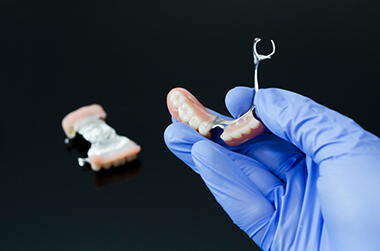 When a tooth is either decayed from a cavity, broken or cracked, it requires a filling. A composite (tooth colored) filling is most often used to repair the tooth after the damaged portion is removed.
When a tooth is either decayed from a cavity, broken or cracked, it requires a filling. A composite (tooth colored) filling is most often used to repair the tooth after the damaged portion is removed.
There are several types of filling materials available, each with their own advantages and disadvantages. Composite fillings and silver amalgam fillings are the most widely used today. The main advantage to composite fillings is that they can be most easily matched to the natural color of the teeth, making the filling much less noticeable.
As with many dental restorations, fillings are durable and should last many years. That said, fillings are not permanent and may need to be replaced at some point.
The Filling Process
Fillings usually require only one appointment. While the tooth is numb, your dentist will remove the damaged or decayed portion. The areathen will be cleaned and carefully prepared for the filling. If there is any damage or decay near the root of the tooth special precautions are taken to protect the area. The filling is then placed, shaped and polished, restoring your tooth to its original shape and function.
Sometimes patients experience sensitivity to hot and cold after a tooth is filled. This is not uncommon and should subside once the tooth acclimates to the new filling.
Porcelain Crowns
A crown is basically a cap that covers the entire tooth’s surface. A crown is used when a tooth cannot be fixed with a filling or other restoration method. The crown not only restores the tooth to its original shape and size, it also strengthens and protects the tooth from future damage.
There are several types of crown materials available, each with their own advantages and disadvantages. Porcelain (tooth colored crown) are the most popular and the most widely used today. The main advantage to porcelain fillings is that they can be matched to the natural color, shape and size of the teeth, making the crown much less noticeable.
As with many dental restorations, crowns are durable and should last many years. That said, crowns are not permanent and may need to be replaced at some point.
When you need a crown:
- Broken or Fractured Teeth
- Decayed Teeth that are beyond the capability of a filling
- Fractured Fillings
- Filling areas that are large
- Tooth with a root canal
The Process of Getting a Crown
Crownsusually require two appointments. During the first appointment, detailed molds or impressions of the teeth are taken to ensure the crown is custom made to match the tooth. A mold also will be used to create a temporary crown until the final custom crown is completed in the dental lab.This usually takes about two weeks.
While the tooth is numb, any decay is removed and the surface is prepared to fit the crown correctly. Once this is complete, the temporary crown is put in place with temporary cement. At this point, the patient is asked to bite down to make sure the alignment is correct.
During the second appointment, the temporary crown is removed, any traces of adhesive are cleaned away, and the new crown is put in place. Again, the spacing and bite are checked to make sure the alignment is correct.
Your new crown will be checked at every dental visit to ensure everything is in good order.
Fixed Bridges
A dental bridge is a permanent appliance and is an excellent way to replace missing teeth.
There are several types of bridges. The type of bridge that is right for each person is dependent on their individual situation. The dentist and patient will make this determination together.A traditional bridge is the most popular type and is usually made of porcelain that is fused to metal. This type of bridge consists to two crowns that go over two anchoring teeth and are attached to artificial teeth, filling the gap created by one or more missing teeth.
Dental bridges are very durable and will last many years. At some point, they may need to be replaced or re-cemented due to normal wear and tear.
Bridge Applications:
- Filling the space between missing teeth
- Maintaining facial shape
- Keeping current teeth from drifting out of position
- Restore chewing and speaking ability
- Upgrading from a removable partial denture
The Process of Getting a Bridge
A bridge usually requires two or more appointments. While the teeth are numb, the anchoring teeth are prepared by removing a portion of enamel to allow for a crown. A detailed impression or mold is made which will be sent to a dental laboratory where the bridge will be custom made to fit the patient. In the meantime, a temporary bridge is made and will be worn for several weeks until the next appointment.
At the second visit, the permanent bridge will be carefully checked, adjusted, and cemented to achieve a correct fit. The dentist may only temporarily cement the bridge, allowing your teeth and gums time to get used to the new bridge. The new bridge will then be permanently cemented at a later appointment.
You will receive care instructions. Proper brushing, flossing and regular dental visits will aid in the life of your new permanent bridge.
Dentures and Partial Dentures
Dentures are removable dental appliances that replace missing teeth and gum tissue. Dentures are made to closely resemble your natural teeth.
There are two types of dentures – complete dentures andpartial dentures. Complete dentures are used to replace all missing teeth. Partial dentures are used in conjunction with the natural teeth still in place. The job of the partial denture is to fill in the space where the missing teeth are as well as keep the remaining teeth from shifting.
There are two types of complete dentures. A conventional denture is placed after a patient has had their permanent teeth removed and the gum tissue has had time to heal. This usually takes four to six weeks. Usually, there are no temporary teeth in place while the gums heal.
Immediate dentures are made ahead of time and are placed in the mouth directly after teeth are removed. This eliminates the need for the patient to go without teeth while healing. The difference is that once the gums do heal, adjustments for inflammation will need to be made to the immediate dentures.
It is reasonable to say that dentures are very durable and should last many years. Adjustments and repairs are likely due to every day wear and tear.
Denture applications:
Complete Denture – Loss of all teeth
Partial Denture – Loss of several teeth
Keeping current teeth in place an in proper alignment
Enhancing smile and facial tissues
Improving speech, chewing and digestion
The Process of Getting Dentures
Dentures usually require several appointments, usually over the course of several weeks. Highly accurate impressions and measurements are taken and used to create your custom denture. Several fitting appointments may be necessary to ensure proper shape, color and fit. At the final appointment, the dentist will adjust and place the completed denture precisely right, ensuring a natural and comfortable fit.
Dentures can be a bit of an adjustment. It is not uncommon to experience some increased saliva, soreness and possible speech and chewing challenges when dentures are new. These issues should subside as your mouth gets used to the dentures.
You will be given care instructions for your dentures. Proper cleaning, good oral hygiene and regular dental visits will aid in the life of your dentures.
Root Canal Therapy
Root canal therapy is needed when a tooth’s nerve is affected by decay or infection. To save the tooth, the dentist will remove the pulp, nerves, bacteria, and any decay. That space is then filled with medicated dental materials that restore the tooth to its full function.
Opting for a root canal means saving a tooth that would otherwise die and have to be removed. While it may seem that removing such a tooth would be the better solution, it is important to consider things such as the repercussions on the adjacent teeth. This could be costly as well as lead to long term problems.
Root canal treatment is very successful and usually lasts a lifetime. It is possible that the tooth would need further attention only if a new infection occurs.
Symptoms that may symbolize the need for root canal therapy:
- Abscess (or pimple) on the gums
- Sensitivity to hot and cold
- Severe toothache pain
- Swellingand/or tenderness
It is possible that no outward symptoms are displayed. Your care team will inspect each of your teeth at your regular well check visits.
Applications for root canal therapy:
- Decay has reached the tooth pulp (the living tissue inside the tooth)
- Infection or abscess has developed inside the tooth or at the root tip
- Injury or trauma to the tooth
The Process of Root Canal Therapy
A root canal procedure requires one or more appointments and can be performed by a dentist or endodontist (a root canal specialist).
While the tooth is numb, a rubber dam is placed around it to keep it dry and free of saliva. An access opening is made on the top of the tooth and a series of root canal files are placed into the opening, one at a time, removing the pulp, nerve tissue and bacteria. If tooth decay is present, it also is removed.
Once the procedure is complete and the tooth is thoroughly cleaned, it is sealed with either a permanent filling or, if additional attention is needed, a temporary filling is put in place.
At the second appointment, the roots and the inside cavity of the tooth are filled and sealed. A composite filling will cover the opening on top of the tooth. It is recommended that any teeth that have root canal treatment should have a crown. This will protect the tooth, prevent it from breaking, and restore it to its full function.
After treatment, the tooth may have some sensitivity, but this will subside as the inflammation diminishes and the tooth heals.
You will be given care instructions after each appointment.Good oral hygiene practices and regular dental visits will aid in the life of your root canal treatment.
Porcelain Veneers
Veneers have become very popular over the course of the last decade. A staple on television makeover shows, veneers can completely reshape your smile. They are custom made for each patient to match the shape and color of the teeth. The material is thin durable porcelain that is tooth shaped. Veneers are fabricated by professionals in a dental laboratory and bonded to the front of the patient’s teeth.
Veneers have application beyond cosmetics. Veneers can often reshape the teeth and can be an alternative to crowns.
It is important to note that veneers are not permanent. While they are durable and should last several years, they will eventually need to be replaced.
Applications for porcelain veneers:
- Cosmetic, creating a uniform beautiful smile
- Crooked or misshaped teeth
- Severely discolored teeth due to medication
- Fill in gaps or spaces
- Fix chipped or broken teeth
The Process of Getting Porcelain Veneers
Getting veneers usually requires two appointments. The good news is that the procedure requires little to no anesthesia. The teeth are prepared by lightly buffing and shaping the surface to allow for the thickness of the veneer. A mold or impression of the teeth is taken and a shade (color) will then be chosen by the patient and the dentist.
At the second appointment, the teeth are cleaned with special liquids to achieve a durable bond. Bonding cement is then placed between the tooth and the veneer. A special light beam is used to harden and set the bond.
You will receive care instructions for your veneers. Proper brushing, flossing and regular dental visits will aid in the life of your new veneers.
Whitening
Teeth whitening is a simple, non-invasive dental treatment used to lighten the color of natural tooth enamel and is an ideal way to enhance your smile.
Having whiter teeth has quickly become one the most important cosmetic concerns of patients. There are a number of ways to whiten or bleach the teeth. There are several at home whitening systems that can significantly lighten and brighten the teeth. The important thing to remember is that whitening products only work on natural enamel. Any composite fillings or dental appliances will not be affected by these products. Replacement of any restorations or dental appliances will be done after the whitening process to match the new shade of the teeth.
Tooth whitening is not permanent. Touch-ups maybe needed every several years, more often if you smoke, drink coffee, tea or wine.
Applications for tooth whitening:
- Fluorosis (discoloration of the teeth due to excessive fluoridation during tooth development)
- Natural wear of outer tooth layer
- Stained teeth due to medications (tetracycline, etc.)
- Yellow, brown stained teeth
The Process of Teeth Whitening
Teeth whitening usually requires two appointments.At the first visit, impressions are made of your teeth to create custom clear plastic trays.
At the second visit, you will try on the trays for proper fit. The trays are worn with special whitening solution, provided by the dentist, either twice a day for 30 minutes or overnight for a couple of weeks depending on the degree of staining and desired level of whitening. It is normal to experience some sensitivity during the time you are whitening your teeth. This should cease once bleaching is stopped.
You will receive care instructions for your trays as well as your teeth. Good oral hygiene, rinsing and regular dental visits willhelp maintain a beautiful white smile.
Diagnosis
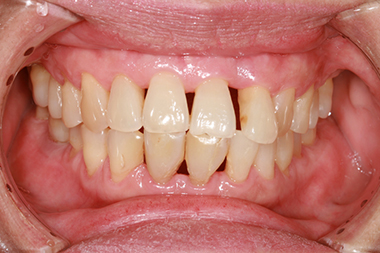 A periodontal check is part of your regular dental check-up. During a periodontal check, asmall dental probe is gently used to measure the pocket between the tooth and the gums. The depth of a healthy pocket measures three millimeters or less and does not bleed. The periodontal probe helps indicate if pockets are deeper than three millimeters. Sometimes, the dentist will speak the numbers as he is checking each pocket so you know the results as he goes. As periodontal disease progresses, the pockets usually get deeper.
A periodontal check is part of your regular dental check-up. During a periodontal check, asmall dental probe is gently used to measure the pocket between the tooth and the gums. The depth of a healthy pocket measures three millimeters or less and does not bleed. The periodontal probe helps indicate if pockets are deeper than three millimeters. Sometimes, the dentist will speak the numbers as he is checking each pocket so you know the results as he goes. As periodontal disease progresses, the pockets usually get deeper.
Your dentist or hygienist will use pocket depths, amount of bleeding, inflammation, tooth mobility, etc., to make a diagnosis that may fall into one of the categories below:
- Gingivitis. Gingivitis is the first stage of periodontal disease. Plaque irritates the gums, making them tender, inflamed and more apt to bleed.
- Periodontitis. Plaque hardens into calculus or tartar. As calculus and plaque build on the surface, gums will begin to recede from the teeth. Deeper pockets form between the gums and teeth and become filled with bacteria and pus. At this point, the gums become red, inflamed and easily bleed. You may start to see some bone loss here.
- Advanced Periodontitis. Teeth will continue to lose more support as the gums, bone and periodontal ligaments continue to be destroyed. Unless treated, the affected teeth will become very loose and may fall out. Moderate to severe bone loss may be present here
Treatment
Periodontal treatment will depend on each individual’s situation. After the evaluation, your dental care team will recommend a treatment plan for your specific case.
If the problem is caught in the early stages of gingivitis, and there is no damage, one or two cleanings will be recommended. You also will receive specific instruction on improving oral hygiene habits to avoid further issues.
If the disease is more advanced, a periodontal cleaning called scaling and root planning will be recommended. During this deep cleaning, the mouth is numbed and the teeth are cleaned by section. Tartar, plaque and toxins are removed from above and below the gum line (scaling) and rough spots on root surfaces smoothed out (planning). This procedure helps gum tissue heal and pockets shrink. Medicated mouth rinses and an electric tooth brush may be recommended to help control infection and aid the healing process.
If the pockets do not heal after scaling and root planning, periodontal surgery may be needed to reduce pocket depths, making teeth easier to clean. In this instance, you may be referred to a periodontist who specializes in gums and the supporting bones.
Ongoing Maintenance
It only takes one day for plaque that remains onyour teeth to turn into tartar. Good daily oral hygiene helps control plaque and tartar formation. Be sure to brush your teeth before bed!
Once your periodontal treatment is completed, your dental care team will recommend regular periodontal cleanings. At these cleanings, the pocket depths will be carefully checked. Plaque and calculus in hard to reach spots will be removed from above and below the gum line.
In addition to your periodontal cleaning and evaluation, your appointment will usually include:
- Examination of x-rays
- Examination of existing restorations
- Examination of tooth decay
- Oral cancer screening
- Oral hygiene recommendations
- Teeth polishing
Good oral hygiene will help keep periodontal disease under control.
